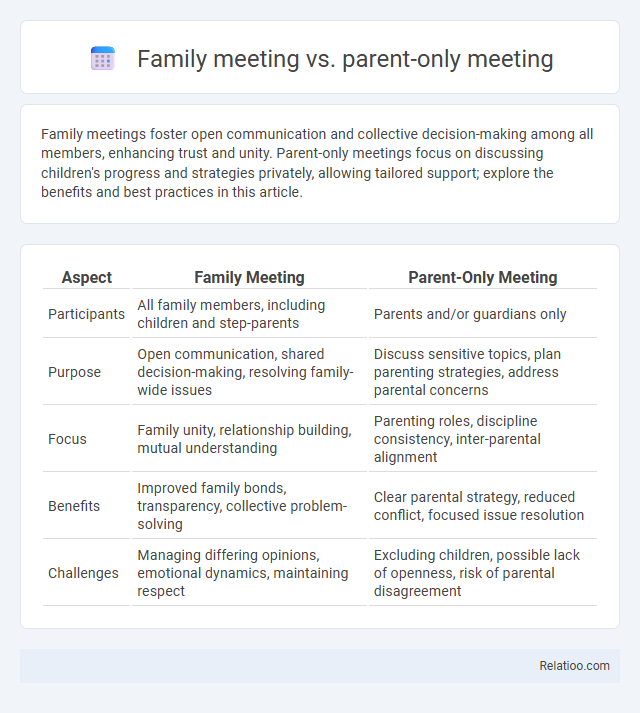Family meetings foster open communication and collective decision-making among all members, enhancing trust and unity. Parent-only meetings focus on discussing children's progress and strategies privately, allowing tailored support; explore the benefits and best practices in this article.
Table of Comparison
| Aspect | Family Meeting | Parent-Only Meeting |
|---|---|---|
| Participants | All family members, including children and step-parents | Parents and/or guardians only |
| Purpose | Open communication, shared decision-making, resolving family-wide issues | Discuss sensitive topics, plan parenting strategies, address parental concerns |
| Focus | Family unity, relationship building, mutual understanding | Parenting roles, discipline consistency, inter-parental alignment |
| Benefits | Improved family bonds, transparency, collective problem-solving | Clear parental strategy, reduced conflict, focused issue resolution |
| Challenges | Managing differing opinions, emotional dynamics, maintaining respect | Excluding children, possible lack of openness, risk of parental disagreement |
Understanding Family Meetings: Purpose and Benefits
Family meetings foster open communication and collective problem-solving among all members, promoting unity and shared responsibility. Parent-only meetings provide a focused environment for adults to discuss parenting strategies and address specific concerns without children present. Your active participation in these meetings enhances family understanding, strengthens relationships, and supports effective decision-making tailored to your family's unique needs.
What Are Parent-Only Meetings?
Parent-only meetings are exclusive gatherings designed for parents to discuss their child's progress, concerns, and strategies without the presence of students or other family members. These meetings provide a confidential space for educators and parents to collaborate on personalized support plans tailored to the child's educational and emotional needs. You can expect focused conversations that address behavioral issues, academic challenges, or special education services, ensuring clear communication and effective problem-solving.
Comparing Family and Parent-Only Meetings
Family meetings involve both parents and children, fostering open communication and collective problem-solving, while parent-only meetings exclude children to focus on adult concerns such as academic progress and behavioral issues. Family meetings encourage shared responsibility and build trust within the family unit, whereas parent-only meetings allow for private discussions that may be sensitive or complex. Effective use of both meeting types supports holistic family engagement and tailored support strategies.
When to Choose a Family Meeting
Choose a family meeting when open communication among all family members is essential to resolve conflicts, plan collective activities, or address shared responsibilities. Parent-only meetings are more appropriate for discussing sensitive issues regarding child discipline, academic progress, or health concerns without the child present. Family meetings foster transparency, encourage participation from every member, and build a cooperative environment for long-term family cohesion.
When Parent-Only Discussions Are Necessary
Parent-only meetings are necessary when sensitive topics such as student behavior, academic concerns, or confidential information need to be addressed without the child's presence to ensure privacy and comfort for honest dialogue. Family meetings are ideal for collaborative problem-solving, fostering open communication among all members, and reinforcing mutual support within the household. When balancing these formats, schools should gauge the subject matter, privacy requirements, and family dynamics to determine whether a parent-only or full family meeting better supports student success.
Impact on Children: Involving vs. Excluding Them
Family meetings that include children foster open communication, helping them feel valued and understood, which boosts their emotional development and sense of security. Parent-only meetings, while allowing adults to discuss sensitive issues more freely, may leave children feeling excluded or confused about decisions that affect them. You can enhance your child's well-being by balancing inclusive family meetings with private parent discussions to address complex matters while maintaining transparency.
Communication Dynamics in Both Meeting Types
Family meetings foster open communication by involving multiple members, facilitating diverse perspectives and collaborative problem-solving within the household. Parent-only meetings concentrate on decision-making and strategy formulation between parents, allowing for focused discussions on child-rearing without external input. Both meeting types shape communication dynamics differently: family meetings promote inclusivity and shared understanding, while parent-only meetings emphasize privacy and unified parental guidance.
Setting Boundaries and Privacy Considerations
Family meetings encourage open dialogue among all members, fostering collective understanding of boundaries and privacy expectations, while parent-only meetings allow caregivers to define and enforce rules without children's input, ensuring clear, age-appropriate limits. Setting boundaries in family meetings promotes collaboration but may risk oversharing, whereas parent-only meetings prioritize privacy by limiting sensitive discussions to adults. Balancing these formats supports effective communication and respect for individual privacy within the family unit.
Best Practices for Productive Family Meetings
Effective family meetings require clear agendas, active listening, and equal participation from all members to address concerns and make decisions collaboratively. Parent-only meetings serve as a focused platform for adults to discuss strategies, resolve conflicts, and plan family activities without children's immediate input, ensuring mature topics are handled discreetly. Establishing consistent schedules, setting ground rules, and encouraging open communication improve the productivity of both family and parent-only meetings, fostering trust and cooperation.
Finding the Right Balance Between Both Approaches
Finding the right balance between family meetings and parent-only meetings involves understanding each approach's unique benefits in fostering communication and decision-making. Family meetings encourage inclusive dialogue and collective problem-solving among all members, while parent-only meetings provide a private space for adults to discuss sensitive issues and strategize effectively. You can optimize family dynamics by scheduling both types appropriately to address immediate concerns while promoting long-term unity and understanding.

Infographic: Family meeting vs Parent-only meeting
 relatioo.com
relatioo.com